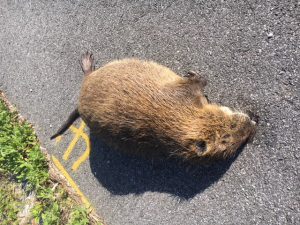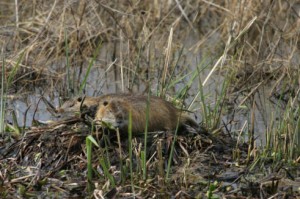I found one in Escambia County, near Perdido Key. It was dead, roadkill, and was quite large. Needless to say, working with invasive species and trying to stay ahead of any new potential problems, I was surprised. I immediately turned around to confirm what I saw as I drove by – it was a nutria.
Many of us have heard of this large rodent (Myocastor coypus), and all the problems it has caused in the state of Louisiana. With the loss of their marshes at stake, it was “all hands” to battle this guy. From reading, it appears it was released across the United States as a potential fur product. I found statements that they may have been brought here from their home in South America as early as the 19th century. Certainly, by the 1920s and 1930s they were here. Today there are records in 18 states across the southeast, the Chesapeake Bay area, and the Pacific northwest – a widespread release and distribution.
It is another classic invasive species story. A nonnative creature is brought to the United States for some specific reason, sometimes accidentally; escapes into the local environment, or is intentionally released; has no natural predators so begins to reproduce at a high rate; and causes environmental and/or economic problems. The United States spends hundreds of millions of each year battling such species.
In the nutria’s case, it is from South America. It was hard to determine whether they were brought over here in small increments to different locations over time, or whether they were brought here in bulk and released into habitats they could survive in, but they were released. It is a large rodent and resembles a beaver except that its tail is round, and not flat, and the profile of their back has an arch to it. They can reach two feet in length, not counting tail, and can weigh up to 20 pounds.
They are herbivores, and some used this animal to control aquatic plants in their ponds. Like many rodents, they have an aggressive reproductive rate to overcoming predation. Nutria become sexually mature within 4-6 months and can produce their first litter at eight months. They breed year-round and typically have three litters / year with 2-13 young / litter. Gestation is 128-130 days and the females are ready to breed within 48 hours of birth.
Nutria like water and can survive in brackish conditions. They live in small social groups that typically have a dominant male, 2-3 females, and the young. Activity is usually at night, moving through the habitat consuming 25% of their body weight in plants each day. They can be seen during daylight hours if food is scarce.
So, what’s the problem?
They eat a lot and burrow for denning. Many waterways are endangered due to their destructive habits. The tunneling and burrowing can compromise the integrity of banks and shorelines around these waterways. Louisiana, being a state with many levees holding water back from communities, you can understand their concern; but communities in Washington, Oregon, and Maryland are facing the same issues. They are carries of certain pathogens and parasites, such as tuberculosis, septicemia, and liver flukes which can be a threat to humans and pets. They also carry nematodes which can trigger a condition known as “nutria itch” in waterways where they are found.
In 1938, 20 nutria were released in Louisiana. By 1958 there were 20 million in the state. There did not seem to be any natural control and the state began losing its marshes. The interesting thing is there are records of releases in Florida as far back as 1955. There are records of this animal in the Pensacola area dating back to 1956. Yet, we do not see the overwhelming numbers found in Louisiana, or with lionfish in our area. I spoke with long time Mobile Delta natural historian Jimbo Meador about the problem there. He said there were lots of nutria at one time and they had hunting tournaments to control them. But when the state began protecting alligators the nutria problem went away – a natural predator after all. He said today you can still find nutria in the Mobile area, but they are restricted to the more brackish areas where alligators are not as common.
Which brings us back to the Pensacola issue.
Many believe that the best method for controlling a new potential invasive species is discover and manage them early before they become widespread and established. Even though this is the first one I have seen in Escambia County, they apparently have been in the area for over 60 years. Something seems to be controlling their populations, which is a good thing. That said, any populations found should be monitored so they do not become more widespread. Currently, the Florida Fish and Wildlife Conservation Commission considers them as one of the furbearers and manages them as such. Live trapping is allowed but you must have a trapping permit to do so. You can actually sell the fur, but you will need a license for this. This may be like the tiger shrimp story, an invasive we are aware of but is not becoming a widespread problem in the county, but I do recommend anyone seeing the creature report to the website data base www.EDDMapS.org so that we can all keep track of where they are and whether they are spreading.
References
California’s Invaders: Nutria (Myocastor coypus), California Department of Fish and Wildlife
https://www.wildlife.ca.gov/Conservation/Invasives/Species/Nutria.
Jimbo Meador (personal communication)
Maryland Mammals: Nutria (Mycastor coypus), Maryland Department of Natural Resources
http://dnr.maryland.gov/wildlife/Pages/plants_wildlife/Nutria.aspx.
Nutria Biology and Identification, Chesapeake Bay Nutria Eradication Project, U.S. Fish and Wildlife
https://www.fws.gov/chesapeakenutriaproject/Biology.html.
Nutria (Myocastor coypus), Florida’s Nonnative Wildlife Species Detail, Florida Fish and Wildlife Conservation Commission.
https://myfwc.com/wildlifehabitats/nonnatives/mammals/rodents/nutria/.
USGS, Nonindigenous Aquatic Species, Nutria (Myocastor coypus)
https://nas.er.usgs.gov/queries/FactSheet.aspx?speciesID=1089.
- Searching for Mangroves in the Florida Panhandle - April 6, 2024
- The Swallow-tailed Kites are Back - March 30, 2024
- Beach Wildlife Walk – Late Winter - March 22, 2024


